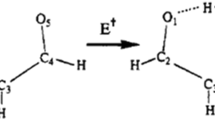Abstract
The role of the cysteine thiolate ligand for the unusual copper coordination geometry in the blue copper proteins has been studied by comparing the electronic structure, geometry, and energetics of a number of small Cu(II) complexes. The geometries have been optimised with the density functional B3LYP method, and energies have been calculated by multiconfigurational second-order perturbation theory (the CASPT2 method).
Most small inorganic Cu(II) complexes assume a tetragonal geometry, where four ligands make σ bonds to a Cu 3d orbital. If a ligand lone-pair orbital instead forms a π bond to the copper ion, it formally occupies two ligand positions in a square coordination, and the structure becomes trigonal. Large, soft, and polarisable ligands, such as SH– and SeH–, give rise to covalent copper-ligand bonds and structures close to a tetrahedron, which might be trigonal or tetragonal with approximately the same stability. On the other hand, small and hard ligands, such as NH3, OH2, and OH–, give ionic bonds and flattened tetragonal structures.
It is shown that axial type 1 (blue) copper proteins have a trigonal structure with a π bond to the cysteine sulphur atom, whereas rhombic type 1 and type 2 proteins have a tetragonal structure with σ bonds to all strong ligands. The soft cysteine ligand is essential for the stabilisation of a structure that is close to a tetrahedron (either trigonal or tetragonal), which ensures a low reorganisation energy during electron transfer.
Similar content being viewed by others
Author information
Authors and Affiliations
Additional information
Received: 9 July 1997 / 26 November 1997
Rights and permissions
About this article
Cite this article
Olsson, M., Ryde, U., Roos, B. et al. On the relative stability of tetragonal and trigonal Cu(II) complexes with relevance to the blue copper proteins. JBIC 3, 109–125 (1998). https://doi.org/10.1007/s007750050212
Issue Date:
DOI: https://doi.org/10.1007/s007750050212




